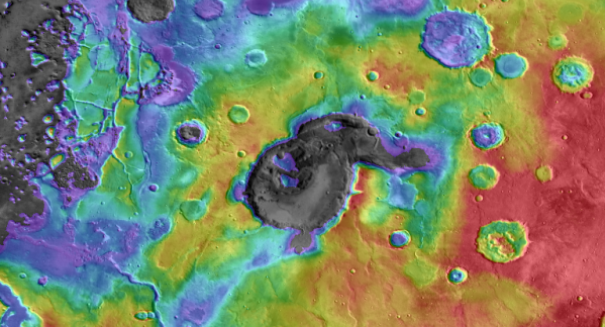
The lack of a nearby coating of ejecta pointed to volcanic activity.
According to a news release from the Planetary Science Institute, supervolcanoes rocked ancient Mars.
Researchers have found what could be a supervolcano on the Red Planet thanks to the work of Joseph R. Michalski, a Senior Scientists at the Planetary Science Institute, and Jacob E. Bleacher of NASA’s Goddard Space Flight Center.
The volcano was previously categorized as an impact crater. However, researchers now believe that the vast circular basin on the face of Mars is actually the leftovers of an ancient supervolcano eruption. This belief is based on photographic evidence and topographic data from NASA’s Mars Odyssey, Mars Global Surveyor and Mars Reconnaissance Orbiter spacecraft, as well as the ESA’s Mars Express orbiter.
Michalski and Bleacher contend that the basin is a volcanic caldera, which can appear similar to a crater created by an impact, as opposed to a volcano.
“On Mars, young volcanoes have a very distinctive appearance that allows us to identify them,” Michalski noted. “The long-standing question has been what ancient volcanoes on Mars look like. Perhaps they look like this one.”
Michalski and Bleacher also believe a big body of magma packed full of dissolved gas emerged through thin crust to the surface rapidly. Just like a shaken soda, this supervolcano would have spread its contents over a great distance if the top came off quickly.
“This highly explosive type of eruption is a game-changer, spewing many times more ash and other material than typical, younger Martian volcanoes,” Bleacher posited. “During these types of eruptions on Earth, the debris may spread so far through the atmosphere and remain so long that it alters the global temperature for years.”
After the material is discharged from the eruption, the depression that remains can disintegrate even more, forcing the ground around it to sink. Yellowstone, Lake Toba and Lake Taupo saw similar eruptions when the Earth was much younger.
Although the Arabia Terra region of Mars is not known for its volcanoes, the researchers took a closer look at the basin, known as Eden Patera, and discovered that it did not have the typical elevated rim of an impact crater. They also could not locate a nearby coating of ejecta, the melted rocket that splatters outside the crater when an object hits the surface.
According to Michalski, the lack of a nearby coating of ejecta pointed to volcanic activity. Bleacher used his volcano expertise to point out features at Eden Patera that typically signify volcanism. For example, the outside of Eden Patera is ringed by the types of faults and valleys that are created when the ground collapses due to activity below the surface. The researchers located a few more basins that are candidate volcanoes nearby.
“If just a handful of volcanoes like these were once active, they could have had a major impact on the evolution of Mars,” Bleacher professed.

The study’s findings are described in detail in the journal Nature.
Leave a Reply